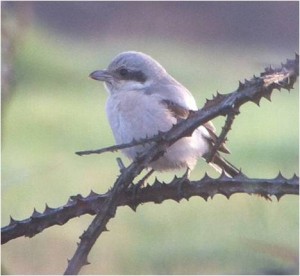A Steppe Too Far?
The steppe grey shrike which appeared recently on the North Norfolk Coast at Burnham Norton brought some controversy during its stay. The bird was, at times, confiding, and was very popular with photographers. Photos of the bird are shown on social media with a mealworm in its beak, and even (apparently) with a dead vole, although I haven’t been able to track down the latter. These were food items placed by photographers to entice the bird closer to their lenses.
I went to see the bird myself, and indeed I took a few photos, though from quite a distance through my telescope using my phone. There were several photographers there at the time, the bird posing nicely and coming to the ground to pick up mealworms within a few metres of the camera scrum. Each time the bird approached there was a round of ferocious mechanical clicking, sounding perhaps a bit like tiny machine guns.
I can’t imagine how many thousands of photos were taken of this bird, a proportion of which made it on to the internet, and a few of which show the bird with mealworms. There were certainly more than enough. Anyway, what interested me was the use of bait to draw the bird closer. My initial reaction to this was that it was wrong in some way. And I still feel it is, but why?
Clearly, if the bird were protected in some way, and there was a question of interference with its nesting site, or it required a licence to photograph, the case is black and white, and photography, let alone baiting, would not be allowed. But this bird was a migrant, and there was no legal issue. Furthermore, the bird willingly came down to feed on the bait, and arguably may have benefited from the food source as it was very considerably lost. What, then, was the difference between providing bait for this bird and feeding birds in your garden? I had to admit, on the face of it, not an awful lot. And wasn’t it better to feed the bird to get good views of it rather than flushing it out of a bush, as has happened with some rare birds?
But wait a minute. There’s something else here. One of the attractions of bird migration to me is the feeling that we are able to make a connection with something wild and free, which knows no boundaries and is to some extent free from human influence. This bird normally spends its time migrating between the steppe of central Asia and the Indian subcontinent, and yet (miraculously) has turned up in north Norfolk. It seems to me the essence of its wildness seems somehow to have been compromised by the baiting.
Also, the baiting of a bird for the purposes of photography (when hundreds of good photos have already been taken) is essentially a selfish act by the baiter, with little regard for the enjoyment of others coming to see the bird. There was a feeling that the extraordinary had been made simply ordinary, and had become a toy of the photographers.
The Nature Photographer’s Network, a US based network (http://www.naturephotographers.net/codeofconduct.html) displays the following in its code of conduct:
- Do not entice a wild animal with food (baiting) in order to get the photo. Allow the animal to be wild, and to move about on its own accord. Note – photos of live-baited birds are prohibited in the NPN Avian Gallery. Photos of baited wildlife are prohibited in the NPN Wildlife Gallery.
The British Wildlife Photography Awards entries page stipulates:
- An image will be rejected if in the opinion of the judges it appears that the image has been taken in such a way that wildlife law or animal welfare requirements may have been breached; protected species or habitats have been compromised; or the image has been otherwise taken in an irresponsible way. If you are licenced to take pictures or visit areas which might otherwise be unlawful you should say so, and we may ask to see the licence if your picture is shortlisted.
- Photographs using model animals or live bait are not permitted.
There are few other codes of conduct for wildlife photography to refer to (on my brief internet search anyway), and with the rise in digital technology and the sheer number of photographers that are around now, surely it’s time for a more prominent and definitive code of conduct. That is not to say that the baiting of the Burnham Norton shrike was right or wrong – but what do you think?

Steppe Grey Shrike – Not shy.
